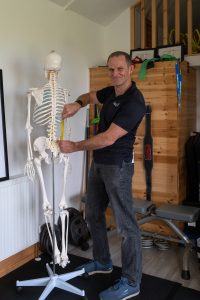The assessment process and programme planning
All programmes begin with an initial consultation and a range of assessments, including:
- thorough medical history
- biomechanics assessment
- fitness assessment
- exercise preferences or phobias
- current dietary habits
- sleeping patterns
- lifestyle factors
- mental health
- general well-being.

This information is then used to create a programme specifically to help you achieve your goals. Depending upon your needs, this may include:
- A bespoke exercise programme, taking into consideration your medical history, physical restrictions, and current activity level.
- Assistance with creating healthy, long-lasting habits for permanent change regarding your diet, work/life balance, regular exercise, and sleep.
- Accountability check-ins to make sure you are staying on track and staying motivated.
- With 20 years experience as a Chef, I can provide easy to follow recipes and shopping lists if required.
The benefits of a Biomechanics assessment
Intrinsic Biomechanics refers to the internal, neuromusculoskeletal mechanisms that generate movement, such as how muscles, joints, nerves, and skeletal alignment work together within the body to enable movement. It focuses on understanding why a movement occurs the way it does, rather than just addressing the observable outcome.
Extrinsic Biomechanics looks at external movement patterns, like how a squat appears visually, or a runner’s stride, using external observations or technology.
Intrinsic biomechanics digs deeper into the root causes—e.g., anatomical structure, muscle activation, and alignment—that lead to those visible patterns.
Key Benefits in Assessment & Programming
- Root Cause Insight
Rather than just correcting a collapsed knee in a squat (a typical extrinsic cue to “push knees out”), intrinsic biomechanics uncovers underlying drivers such as pelvic alignment, fascial restrictions, or neural tensions. This enables far more precise and effective interventions.
- Targeted, Individual Interventions
By evaluating internal function—like joint mobility, muscle activation patterns, neural glide, or fascial tension—coaches can craft tailored corrective strategies, recommending specific exercises, mobilization, or nerve-release techniques.
- Improved Movement Efficiency & Performance
Correcting intrinsic dysfunctions lays the foundation for more efficient and powerful external movement. Addressing internal imbalances can translate into smoother technique, reduced energy waste, and enhanced athletic output.
- Injury Prevention & Chronic Pain Reduction
Focusing on intrinsic factors—like restoring balanced tissue function and neural mobility—can significantly reduce compensatory stresses and chronic discomfort, often yielding relief where other treatments have failed.
- Objective Progress Tracking
Practitioners can re-assess immediate changes post-intervention—such as increased range, reduced asymmetry, or improved activation—offering real-time feedback and measurable progress tracking.
The I Move Freely exercises are part of the Intrinsic Biomechanics programme. This involves an initial assessment to identify where there are restrictions in movement. An individualised set of easy-to-do exercises are then provided and progress is monitored regularly.
The programme has three distinct phases:
- Preparation and Capacity – provides low-grade, subtle techniques to affect the 3 sub-systems and create capacity by using anti-spasm and nerve mobilisation exercises.
- Stability and Control – requires the pelvis and spine realignment achieved through stage 1, then specific, periodized core training which creates a well-balanced base of support around the entire trunk creating confident control.
- Function and Performance – Strengthens the shoulders, knees, and feet to allow better ‘function’ to be ‘fit for purpose.
All of which reduce risk and optimise performance ability.
For further information please contact Paul on 0780 0780 039.
